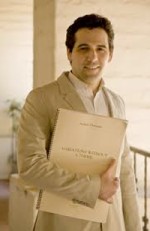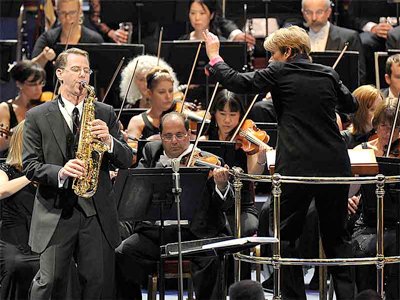by Mike Telin

Although Dorman’s concerto was completed in 2003, its scheduled premiere with an Israeli orchestra was abruptly cancelled, and never re-scheduled. Finally, in October of 2012, the work received its first performance by Joshua Redman and the Alabama Symphony. Dorman explained that the concerto was originally programmed for a series designed to highlight the crossing of musical genres. He took a jazz-oriented approach to the piece — “John Coltrane meets contemporary classical music,” as he described it. “I was very happy that we were able to get Joshua Redman to play the premiere. He’s the real thing on the jazz side. This week it will be played by a master classical saxophonist, so we’ll get to hear the other side of the piece.”
Dorman was quite pleased that Timothy McAllister agreed to learn the concerto. “CityMusic’s executive director and I were talking about the piece. Eugenia Strauss asked, ‘who is the best classical saxophone player?’ When you ask that question, everyone points directly to Tim.”
Conductor Marin Alsop is among those for whom Timothy McAllister seems to be the “go-to” classical saxophonist. “I’ve been saxophonist-on-call for Marin at the Cabrillo Festival for some time,” McAllister pointed out during a telephone conversation from Ann Arbor, where he serves as Associate Professor of Saxophone at the University of Michigan. “I’ve performed two concertos at Cabrillo, and last year premiered John Adams’s concerto with Marin there during the Festival.” McAllister estimates that he has now performed Adams’s concerto roughly 16 times, most recently in September at the Proms in London with Alsop and the BBC Symphony (pictured below). McAllister is also only the second saxophonist to perform a concerto at the Proms.
Indeed, it was Marin Alsop who first introduced Avner Dorman and Timothy McAllister to one another. “I first met Avner about four years ago when Marin programmed one of his pieces at Cabrillo,” McAllister said. “He planted in my ear the fact that he had written a saxophone concerto. We’ve stayed in touch. Then he told me that he was now the artistic director of this terrific orchestra in Cleveland and felt it would make a real splash to begin this season with the concerto. I was certainly willing to accept the opportunity even though I barely knew anything about the piece. But knowing Avner and his music, I knew it would be a hit.”
McAllister said he finds the 16-minute concerto for soprano sax to be extremely attractive, but very challenging. “I’ve played concertos that only make use of one facet of the instrument. For example, some only highlight its lyrical quality. But this concerto has everything: classical references, jazz references, and it draws upon world music too. There is a little improvisation – not in a jazz style but by using themes from the rest of the piece. The soprano sax has a very chameleon-like nature to it. It can take on oboe, English horn and trumpet sonorities. It can also produce a number of exotic sounds, which Avner uses a lot.”
The opportunity to perform many new concertos by major composers has played a prominent role in the advancement of McAllister’s career. And bringing this new repertoire to the public helps the cause of the classical saxophone around the world. “Once we saxophonists bring a piece like Avner’s concerto into the fold, then we can unveil the fact the there is a lot of repertoire out there by well-known composers. If you list every Pulitzer Prize-winning composer during the past twenty years, you’ll find that they all have written something for the saxophone. They all believe in the instrument and have contributed to its repertoire. It’s also interesting that November 6 marks the 200th birthday of its inventor, Adolphe Sax, and these CityMusic concerts fall very close to that date. So maybe its time to make another big push for the instrument.”
As he did last year, Avner Dorman will open this season with a program that highlights CityMusic’s wind section. “Some of our wind players have been part of the orchestra from the very beginning. Programming a piece like the Dvořák Wind Serenade allows the audience to gain a new appreciation for those folks who are usually in the back of the orchestra. The piece is interesting because it includes a cello and a bass, yet it sounds like a full orchestra. Programming this piece is a wonderful way to let the audience inside the orchestra, and gain a little better understanding of the role of the winds.”
The concerts will open with Mozart’s Symphony No. 35, “Haffner,” which Dorman points out is probably the best-known piece on the program. “I think it’s a great opener. It’s an exciting piece to play and I thought it would be a great way to celebrate the beginning of the new season.”
This week’s concerts will conclude with a work that Avner Dorman thinks is one of Haydn’s greatest symphonies, the “Farewell,” so named because at the end, the musicians leave the stage one by one. Audiences today find that funny, but Dorman likes to remind them that Haydn wrote it as a protest piece. “This was Haydn’s way of letting his employer, Prince Nikolaus Esterhazy, know that if he didn’t change a few things the musicians were all going to leave. But better yet, historical records show that Haydn’s plan worked. So I guess you could say that Haydn was a union leader. The musicians needed their voices to be heard and Haydn made it happen for them. He probably took a big risk by doing it.”
“If you look at the score, suddenly the lines just end as the players leave the stage. It’s kind of a Berio thing to do. I think it’s just a phenomenal masterpiece, and as I revisited it I’ve become more and more in awe of the piece. It’s an unusual way to end the concert because it’s not often played at the end of a program. It’s an amazing piece and one that everyone has heard of, but very few have heard live. It’s in f-sharp minor – a very dark key — and full of emotional turbulence from beginning to end.”
Published on ClevelandClassical.com October 14, 2014.
Click here for a printable copy of this article.




